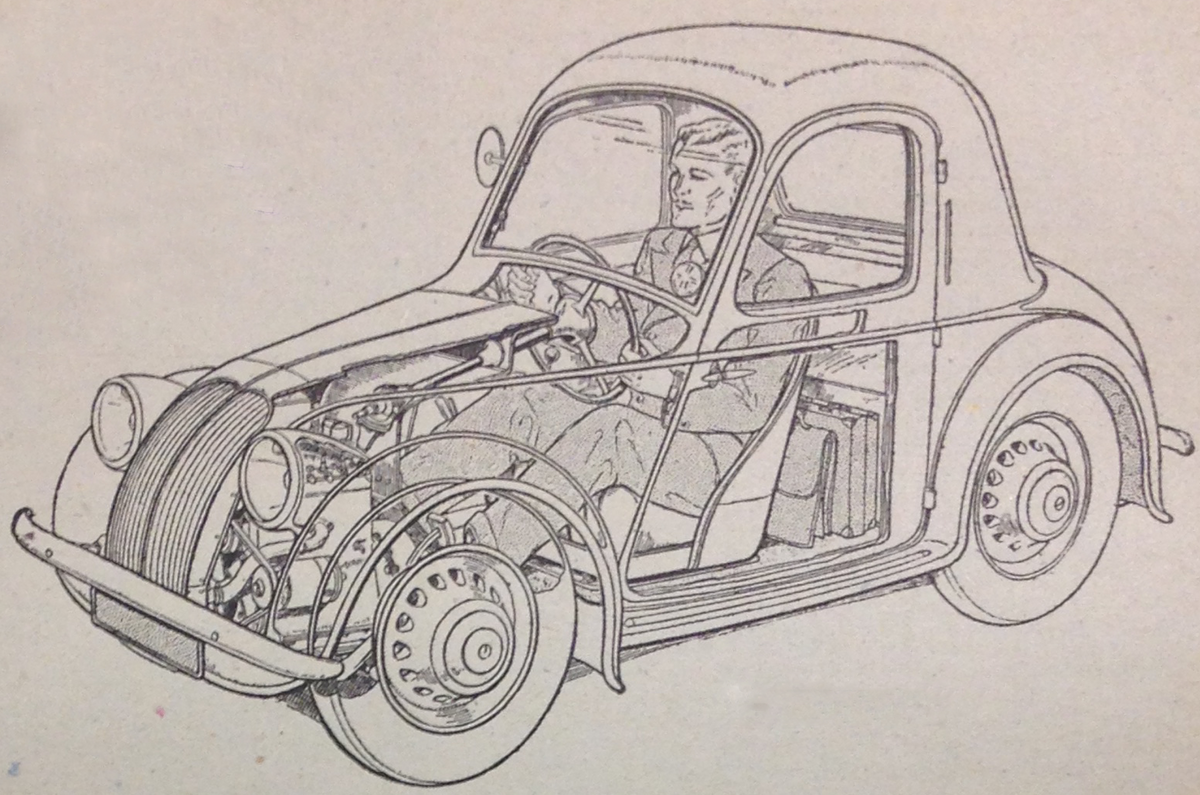By the 1930s, motoring was common among the middle and upper classes, and congestion was already a problem. Then private motoring came near to a grinding halt for the duration of World War II.
Here, from a 1942 edition of Autocar, a businessman pitches his plan for solving the problem of the rush hour post-war. His dream car is similar to the city cars of today, only smaller. In fact, it seems very reminiscent of today’s car of the future.
“Before the war I owned a big American car and a Standard Eight. The idea was that I should use the American car for journeys and when I travelled en famille, and the Standard for my daily trip to town. But it did not work out quite like that,” our man began. “If my wife was going out, which was most days, she would want a car herself, and, as she never really felt at home with the Yank, she always took the Standard, which, of course, left me with the big car for my 20-mile journey to my office and for the run of five miles from the office to the works.”
This car had to be short, narrow and manoeuvrable, the writer says.
“It would be a little single-seater saloon – I can’t remember ever having anyone in the Standard other than soldiers to whom I have given a lift. So I want a single-seater with just enough room to take a small case or parcels behind the driver’s seat. The advantage of the single-seater is, of course, that it would be quite narrow – about 3ft 6in, I should think. The wheelbase, too, would have to be very short and, above all, I must have a steering lock comparable with that of the London taxi.”
To give you an idea of the scale, this is just 4in wider than 1962’s comical Peel P50.
“I want to be able to park it in the smallest space that I can find, and I want to be able to emulate the cyclists and motorcyclists who worm their way in and out of the traffic waiting at traffic blocks until they are up to the lights,” our man continued.
“The engine would be about 500cc, or even 400cc, but must be large enough to give the car good acceleration, and for the sake of smoothness and comfort I should want it to be a four-cylinder model with the conventional water cooling. I want a real car that will have the refinements of the large models.”
Again, this ideal car sounds ideal for today – it’s almost a wonder this idea didn’t take off post-1945.
Fuel economy was also a concern: “With a 500cc engine I should expect at least 50mpg; by fitting an engine of 400cc the saving in cost would hardly seem worthwhile. The difference between 50mpg and 60mpg would mean about the cost of two cigarettes a day, and the saving in tax would be 25 shillings a year, so I most certainly would prefer the extra 'zip' of the 500cc engine.”
“I should consider this single-seater as an annual season ticket on the railway. It is, of course, impossible to place a figure for the cost until we see how things shape after the war and cars are in production once more; but judging by pre-war standards, I should not expect to have to pay more than £75 for the car.”
Such a price would equate to about £3187 – around £2800 cheaper than the UK’s current cheapest car, the Dacia Sandero – and a seemingly realistic expectation even today.
However, our man could see the potential downfalls: “I am, of course, willing to admit that this type of car would not appeal to everybody,” before countering that with: “The desire which is inherent in most motorists to own something a little different from the next man would place a number on the road to start off with,” something that still rings true today.
Autocar’s hopeful businessman concluded with: “It is, of course, impossible to foretell how things in the motor trade will be in 10 years or even five years, but if they are anything like we are hoping for then I hope to see a single-seater on the road in the not too distant future, even if it is only a single-seater model of the smallest car made.”
Unfortunately, no such car has ever made the market in any significant number. However, with the industry moving at such a pace, who knows what the near future could hold?




Join the debate
Add your comment
one-man car?
Single-Seater Scooter Car / Moped Car - An Idea Worth Pursuing
Top speed should be electronically or mechanically limited to 70 mph as well as feature a decent size boot or luggage compartment, which can be utilized for both personal and limited commercial uses (e.g. delivery, etc).
Such a vehicle should be limited to Automatic / CVT gearboxes and could also be adapted for use by disabled drivers forming the basis of a significantly safer 4-wheeled successor to the Invacar.
In terms of powertrain would ideally like to see Single-Seater vehicles use 500-750cc engines, perhaps even hybrids akin to the Suzuki Twin followed later by alternate drivetrains.
The best of the 3-wheeled Single-Seaters should draw upon the HMV Freeway (albeit upscaled), while the best of the 4-wheeled Single-Seaters should have to draw upon the Daihatsu Midget II.
Ideally would love to see a modern Single-Seater equivalent of the FMR Tg500 or the short-lived 4-wheeled Bond Bug by the Webster Motor Company.
Not a bad idea
Sadly though, a single seater car wouldn't weigh a quarter of a conventional car, let alone a cost a quarter of the amount.But if these problems could be solved, I'd have one...